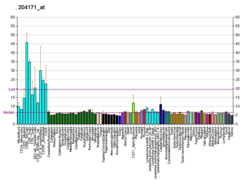S6K1
| RPS6KB1 | |||||||||||||||||||||||||||||||||||||||||||||||||||
|---|---|---|---|---|---|---|---|---|---|---|---|---|---|---|---|---|---|---|---|---|---|---|---|---|---|---|---|---|---|---|---|---|---|---|---|---|---|---|---|---|---|---|---|---|---|---|---|---|---|---|---|
 | |||||||||||||||||||||||||||||||||||||||||||||||||||
| |||||||||||||||||||||||||||||||||||||||||||||||||||
| Identifiants | |||||||||||||||||||||||||||||||||||||||||||||||||||
| Aliases | RPS6KB1 | ||||||||||||||||||||||||||||||||||||||||||||||||||
| IDs externes | OMIM: 608938 MGI: 1270849 HomoloGene: 81703 GeneCards: RPS6KB1 | ||||||||||||||||||||||||||||||||||||||||||||||||||
| |||||||||||||||||||||||||||||||||||||||||||||||||||
| |||||||||||||||||||||||||||||||||||||||||||||||||||
| |||||||||||||||||||||||||||||||||||||||||||||||||||
| |||||||||||||||||||||||||||||||||||||||||||||||||||
| |||||||||||||||||||||||||||||||||||||||||||||||||||
| Wikidata | |||||||||||||||||||||||||||||||||||||||||||||||||||
| |||||||||||||||||||||||||||||||||||||||||||||||||||
Le S6K1 (« S6 kinase 1 ») est une protéine ribosomique à type de kinase dont le gène, RPS6KB1 est situé sur le chromosome 17 humain.
Rôles
Il contribuerait à la survenue d'une résistance à l'insuline et d'un diabète de type 2 par l'intermédiaire du système mTOR[5]. Son absence, chez un modèle animal, protégerait contre l'obésité et préserverait la sensibilité à l'insuline[6], en empêchant la prolifération des adipocytes au cours d'un régime riche en graisse[7].
Cible thérapeutique
Plusieurs molécules inhibitrices du S6K1 sont en cours de développement pour traiter le diabète[8].
Notes et références
- ↑ a b et c GRCh38: Ensembl release 89: ENSG00000108443 - Ensembl, May 2017
- ↑ a b et c GRCm38: Ensembl release 89: ENSMUSG00000020516 - Ensembl, May 2017
- ↑ « Publications PubMed pour l'Homme », sur National Center for Biotechnology Information, U.S. National Library of Medicine
- ↑ « Publications PubMed pour la Souris », sur National Center for Biotechnology Information, U.S. National Library of Medicine
- ↑ Um SH, D’Alessio D, Thomas G, Nutrient overload, insulin resistance, and ribosomal protein S6 kinase 1, S6K1, Cell Metab, 2006;3:393–402
- ↑ Um SH, Frigerio F, Watanabe M et al. Absence of S6K1 protects against age- and diet-induced obesity while enhancing insulin sensitivity, Nature, 2004;431:200–205
- ↑ Carnevalli LS, Masuda K, Frigerio F et al. S6K1 plays a critical role in early adipocyte differentiation, Dev Cell, 2010;18:763–774
- ↑ Ye P, Kuhn C, Juan M et al. Potent and selective thiophene urea-templated inhibitors of S6K, Bioorg Med Chem Lett, 2011;21:849–852
 Portail de la biologie cellulaire et moléculaire
Portail de la biologie cellulaire et moléculaire  Portail de la médecine
Portail de la médecine

















